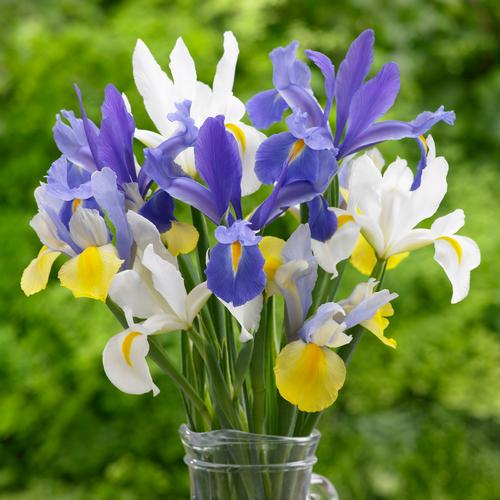Hadeco
Dutch Iris - Mixed - 50 bulbs p-pack (211)
Dutch Iris - Mixed - 50 bulbs p-pack (211)
SKU:0059999491P
Log in to purchase
Dutch iris come in dazzling blue, white and yellow colours and are a delightful cut flower.
Iris (Dutch)
How to plant, care and grow Iris (Dutch)
There are 260 different species of Iris and they are all from the northern hemisphere. They can be divided into two different groups, rhizomes and true bulbs.
Dutch iris is a true bulb. It was created in Holland by crossing the Spanish Iris (I. xiphium) from Spain, Portugal, southwestern France and North Africa and the northwestern African Iris (I. tingitana). At its mature height, it is 40-90cm tall.
Seasons and planting
Before planting Dutch Iris, work compost into the soil and put it on the soils surface to create a cooling mulch. This plant naturally flowers during spring but it can be forced (manipulated) to flower earlier. If the bulb has not been treated, it should be planted in early May when the weather is cooler for winter. They should be planted at a depth of 5cm with 7cm between the bulbs. The lowest temperature that this plant can tolerate is 0°C.
After flowering, the bulbs can be lifted in November during their dormancy – the foliage will yellow as dormancy begins. In South Africa, the spring time is usually too warm for the plant to have the same level of flowering in their second season.
Propagation
Small bulblets can be pried off the mother bulb and planted for the next season.
Iris (Dutch)
How to plant, care and grow Iris (Dutch)
| Family | Iridaceae |
| Name derived from | Iris is the messenger of the Gods and a personification of the rainbow in Greek mythology. All of the colours in the spectrum are found in this genus. |
| Common name | Iris, flag lily, sword lily |
| Sun Exposure | Full sun/semi-shade. |
| Flower Colours | Range of blues, white and yellow. |
| Frost Tolerance | Moderate |
| Predators | Snails, slugs, thrips and aphids |
There are 260 different species of Iris and they are all from the northern hemisphere. They can be divided into two different groups, rhizomes and true bulbs.
Dutch iris is a true bulb. It was created in Holland by crossing the Spanish Iris (I. xiphium) from Spain, Portugal, southwestern France and North Africa and the northwestern African Iris (I. tingitana). At its mature height, it is 40-90cm tall.
Seasons and planting
| Jan | Feb | March | April | May | June | July | Aug | Sept | Oct | Nov | Dec | |||
| Available | ||||||||||||||
| Plant | ||||||||||||||
| Flowering | ||||||||||||||
Before planting Dutch Iris, work compost into the soil and put it on the soils surface to create a cooling mulch. This plant naturally flowers during spring but it can be forced (manipulated) to flower earlier. If the bulb has not been treated, it should be planted in early May when the weather is cooler for winter. They should be planted at a depth of 5cm with 7cm between the bulbs. The lowest temperature that this plant can tolerate is 0°C.
After flowering, the bulbs can be lifted in November during their dormancy – the foliage will yellow as dormancy begins. In South Africa, the spring time is usually too warm for the plant to have the same level of flowering in their second season.
Propagation
Small bulblets can be pried off the mother bulb and planted for the next season.




